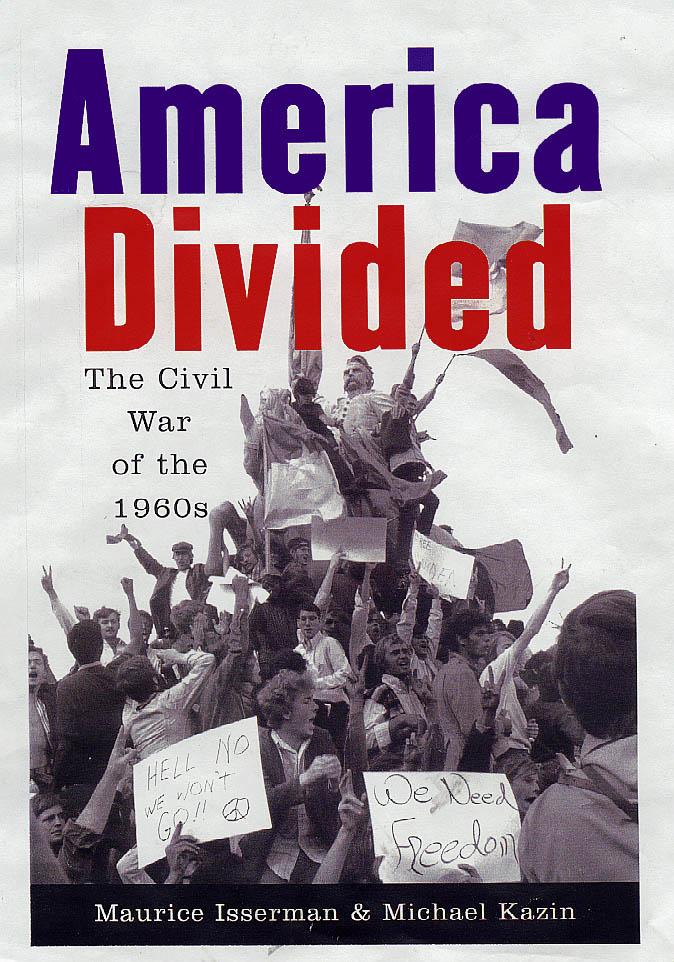
America Divided
The Civil War of the 1960s
Maurice Isserman
and
Michael Kazin
Available 11/99
 |
America Divided The Civil War of the 1960s
Maurice Isserman and Michael Kazin
Available 11/99
|
Like a Civil War
As the 1950s drew to a close, the organizers of the official centennial observances for the Civil War scheduled to begin in the spring of 1961 and to run through the spring of 1965, were determined not to allow their project to become bogged down in any outmoded animosities. Among other considerations, much was at stake in a successful centennial for the tourism, publishing, and souvenir industries; as Karl S. Betts of the federal Civil War Centennial Commission, predicted expansively on the eve of the celebration, "It will be a shot in the arm for the whole American economy." Naturally, the shot-in-the-arm would work better if other kinds of shots, those dispensed from musketry and artillery that caused the death and dismemberment of hundreds of thousands of Americans between 1861 and 1865, were not excessively dwelt upon. The Centennial Commission preferred to present the Civil War as, in essence, a kind of colorful and good-natured regional athletic rivalry between two groups of freedom-loving white Americans. Thus, the Commission's brochure "Facts About the Civil War" described the respective military forces of the Union and the Confederacy in 1861 as "The Starting Line-ups."
The Authors
Maurice Isserman, William R. Kenan, Jr. Professor of History, at Hamilton College, and Michael Kazin, Professor of History at Georgetown University.
The Reviews
"American Divided: The Civil War of the 1960s is a riveting read, brimming with lively anecdotes, original insights, sharp analysis, and scrupulous scholarship. It is, far and away, the most compelling single volume history of the 1960s currently available. A superb book."
-Douglas Brinkley, The Eisenhower Center for American Studies, University of New Orleans
Wednesday, September 15, 1999, Kirkus Review: "Isserman, a specialist in leftist politics, and Kazin, a student of modern conservatism, make a solid tag team. Their thorough-going research and vivid writing make this a book of interest to students and general readers alike."
"An impressive achievement. The most comprehensive, comprehensible history of the American 1960s that I know."
-Todd Gitlin, New York University
-Nelson Lichtenstein, University of Virginia
-Lizabeth Cohen, Harvard University
-Elinor Langer, Fellow of the Open Society Institute and author ofJospehine Herbst
Sunday, September 5, 1999, The Washington Post, "The Fall Preview" by Marie Arana: Will books, like wonders, never cease? That certainly seems to be the case, as American publishers teeter on the cusp of the millennium... There is no end to history, it seems. Not in the book industry, anyway, where historical tomes -- about everything from century-old natural disasters to the evolution of kitchenware -- continue to fuel the market...American social history is represented by: The Encyclopedia of the Irish in America, edited by Michael Glazier (Notre Dame); Something in the Soil: Field-Testing the New Western History, by Patricia Nelson Limerick (Norton, Feb.); America Divided: The Civil War of the 1960s, by Maurice Isserman and Michael Kazin (Oxford, Nov.); Lay This Body Down: The 1921 Murders of Eleven Plantation Slaves, by Gregory A. Freeman (Lawrence Hill Books); and T.H. Watkins's comprehensive account of the Great Depression, The Hungry Years (Holt, Oct.).
In November, 1999 you may order American Divided: The Civil War of the 1960s
from Oxford University Press
or to order this and other books by Maurice Isserman from:
Any questions about the book?
Email misserma@hamilton.edu
Return to: History Department * Maurice Isserman * www.hamilton.edu